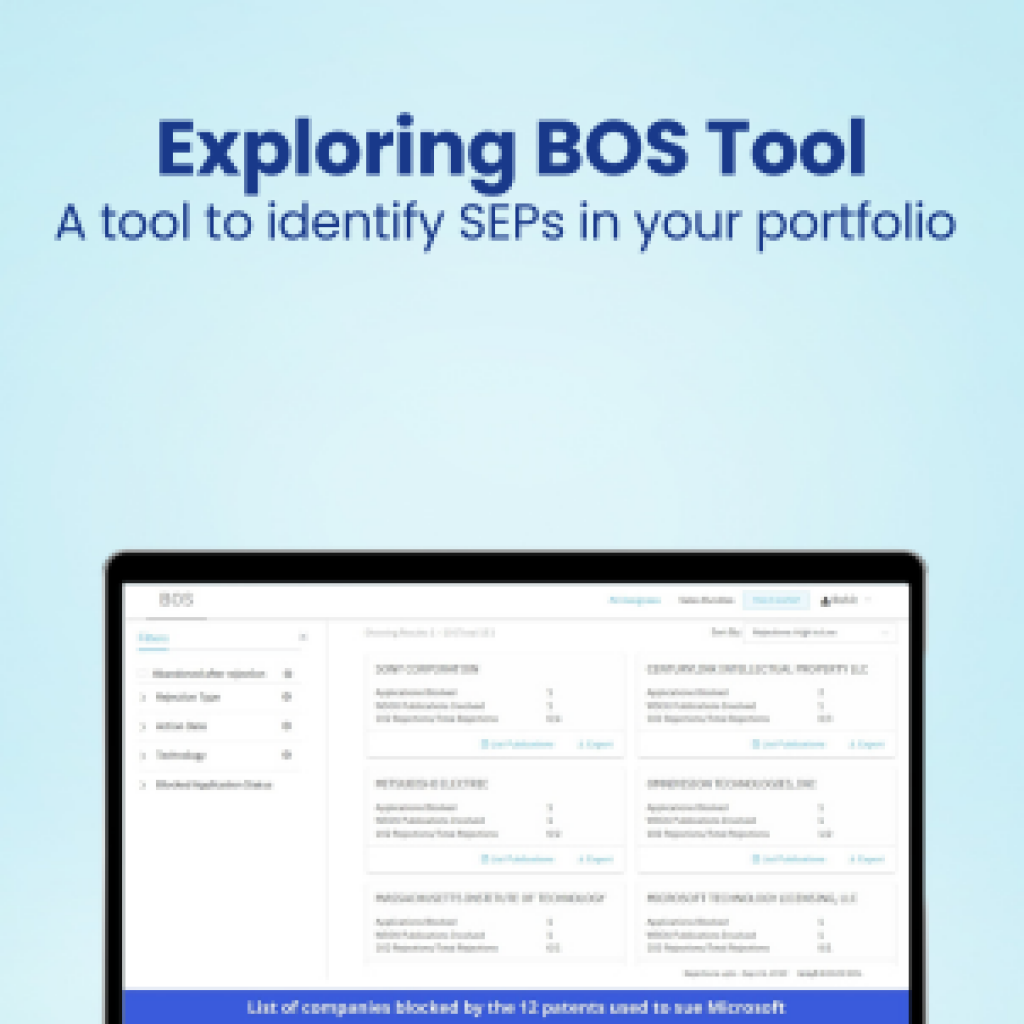In recent years, Standard Essential Patents (SEPs) have been the hot topic of interest for the R&D-Sales and Marketing departments of various companies.
After all, confirming the patent as SEP more or less opens the doors for a company to earn royalties worth tens of millions of dollars. It could add to your revenues.
But, in the pursuit of identifying SEPs, is there anything that can go wrong?
Yes. In fact, a lot of things can go wrong. Even missing small details or ignorance of certain factors may lead to a miss of these gem patents from a large patent portfolio, which directly affects the monetary aspect of the company and your monetization plans.
What are these factors? – you ask.
We tried to brainstorm and list all the reasons that can lead to a miss of a SEP, and believe me when I say this: a single article cannot even come close to covering all these reasons or points. Yes, that is how big the list is.
SEPs could be missed or analyzed inaccurately due to some generic reasons, such as researchers’ inability to identify the link between the patent specifications, or a patent is bought by another company, the patent is dead, etc. For example, a patent, let’s say US98XXXXXB1 despite being a SEP, may not help the company yield millions as it may already be expired or sold out to another company. All these are well known and already talked about in detail in other places.
However, even if the above checklist is fulfilled, you may still find yourself in the pit where essential patents are in the vicinity and yet not approachable.
Overall, it is important for companies to regularly scrutinize the patent portfolio, technology-wise overlapping is needed instead of word-based mapping. Optional SEPs need to be proven as mandatory SEPs. Further companies need to consider some factors that may hinder the company from earning millions even though they proved the patent as SEP.
Let me present to you four such factors wherein although the patent has the potential to overlap the standards, it is still either missed or not used to its full potential, and what can be done to overcome these situations.
Revisiting crucial patents and tallying those with new releases.
With each release of a standard, some new features or functionalities are added to the technology standard.
To locate SEPs, companies often scrutinize their patents against different releases. Is it done regularly? If not, then it is a loophole.
You might ask – Then why are these patents not checked iteratively? Because it takes a lot of time.
Let’s take an example to explain this — Say a patent – US98XXXX3 is related to Emergency Session handover between 3GPP and non-3GPP networks. You check this patent in 2015, w.r.t the 3GPP specifications Release 12 (2014-2015). You find that this idea is not yet introduced in the standards. You conclude your analysis and move ahead. However, the required idea is later added in 2016, in the latest release of Release 14 (2016-17). But, you have now completely forgotten about any such patent that is there in your portfolio.
By not regularly checking your patent w.r.t the latest releases, you have lost the opportunity of getting a SEP out of one of the most important patents in your portfolio.
What can be done to overcome this: Maintaining a list of close patents along with the missing elements can be helpful in such situations. Whenever a new release comes, you can easily check the missing elements.
Risk of Superficial word mapping
Have you seen wine tasters? Anyone can drink wine but wine tasters are especially gifted in recognizing minute details.
On similar lines, it is very important to get your portfolio scanned by an expert searcher.
But why are we talking about this in the middle of a SEP article?
The reason being that a broad interpretation of the claim elements and mapping the standards based on those elements may seem fine to you, but it will not make the patent an actual SEP. It is essential that you properly link the claim construction, not going on the word meaning, but on the actual technology. Otherwise, issues may arise.
Let’s take the example of US95XXX2B2 – a patent that relates to a method for facilitating macro antenna tuning based on the number of network attachment attempts performed. When we move to the claims, we find a broad term – “network planning” being used for the technology concept – “macro antenna tuning.” That is great, right? You look for any planning aspect (which is not what is required as per claims) in the standards, and you declare your patent SEP. However, the standards talked about these various planning aspects even before the cut-off date of the patent.
So, you see – you have not found a SEP. Instead, you have found a prior art for your patent, if you go by those interpretations. Instead of claiming royalties, you may have to witness invalidation cases
What can be done to overcome this: Understand and map the patent’s claim with the standards, not just with literal word meaning, but also on the actual concept. It is a delicate balance that searchers need to maintain in the interpretation.
System Conundrum – Unavailability of the components of the system
Let’s say you have a patent – US82XXXXB2 that claims an apparatus (probably a mobile device) having components X, Y, and Z.
X component enables the coupling of the apparatus to a network entity that is deployed in the communication network. While component Y enables the exchange of the content with the network entity, component Z ensures that the exchange of content is independent of utilizing a resource from the core network. Below is the pictorial depiction of the same –

Coming to the standards, you can easily identify a system that allows multiple network entities to couple with a centralized network entity. The system includes a controller to enable the exchange of content with the network entity and allows proper resource allocation. Everything is there to make it a SEP, then why are we still creating a fuss?
It is because the apparatus that was being claimed in the patent is not exactly the one in the standard spec. Say there is a product A is in the market, which follows all the intricacies described in the spec., so do you have the authority to claim rights from that product owner? Probably not!
Because your patent claimed all those components in a single apparatus. Whereas in the standard specification, even though the apparatus does all the functions, the components that provide the functionality are not in a single apparatus. This makes the standard different from what is being claimed.
What can be done to overcome this: Systems claims are often tedious, one should thoroughly review the standard specifications i.e. whether it is as per the apparatus claimed in the patent before declaring the patent as SEP.
Another option before evaluating any patent as non-SEP is to check whether the patent has a method claim. Since method claims are not limited to how different units (described in the patent) are arranged, they are relatively easy to prove as SEP.
Conditional SEPs
Conditional SEPs are patents that overlap on the optional features of the standard specifications or may overlap on the text that includes modal verbs, such as “may,” “can,” “could,” “might,” etc.
Now, why is this an issue?
To simply answer, this may create a lot of difference.
Let me explain. Suppose the patent – US91XXXXB1 mentions the features 1, 2, 3 & 4 to improve the network’s performance. Coming to the standard specifications – features 1, 2 & 3 are mandatorily done, whereas feature four is optionally disclosed. You may use feature 4, feature 5 (which is not in the patent but is there in the specs), or none.
So, a product comes down the time lane, which can get the same result of network performance improvement by using the specification method (features 1, 2 & 3). However, you may not claim royalties from the product unless and until you are sure if feature 4 is being used or not.
Optional SEPs, thus, always come with limitations and are a roadblock while monetizing the patent asset.
What can be done to overcome this: As multiple specifications disclose a single idea, therefore, one possible solution could be to identify if any other specification mentions the same concept and excludes the modal verbs like – “may,” “can,” “could,” “might,” etc. The patent can be termed mandatory SEP for that specification. It is a far-fetched shot but worth trying.
This gets us to the end of our list for now but there is a lot more you should know about and take care of to make sure you don’t lose out on the opportunity to get more gem patents in your patent portfolio.
For a portfolio spanning thousands of patents, keeping track and finding these SEPs can be really difficult and it’s easy to miss out on significant candidates. How do you overcome that problem?
This is where we can help. We have helped various Fortune 1000 organizations identify the SEPs in their portfolio and we can help you do the same. To know in detail about our process, Get in touch with us and we will get all your questions answered.

Read Next: How telecom companies can identify 5G SEPs in their portfolio?
Authored by Shivam Kansra, SEP team.









